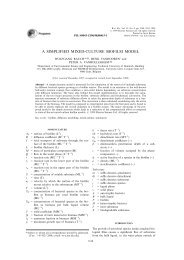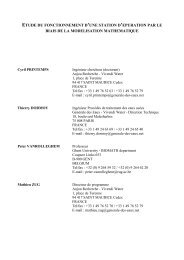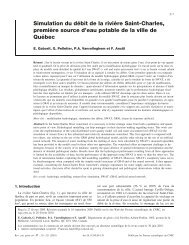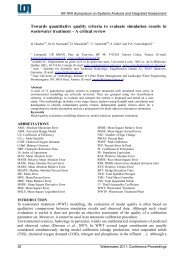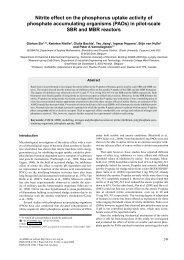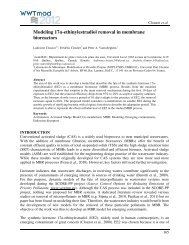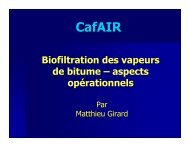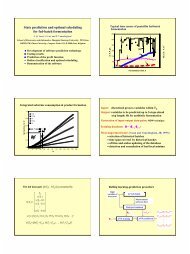22 J. F. VAN IMPE ETAL.XIO-43.53.0 0.002 0.004 0.006 0.008 0.01 0.012 0.014 0.016 0.018 0.02PIlhlFigure 3. Dabes-type kinetics rh) for various values <strong>of</strong> parameter Bfamily <strong>of</strong> models - that is completely smooth within <strong>the</strong> given boundaries <strong>of</strong> <strong>the</strong> parameterB, thus assuring <strong>the</strong> continuity <strong>of</strong> afi/ax, for all i and j. Moreover, as BZO, we comearbitrarily close to <strong>the</strong> original model. In Figure 3 we show some members <strong>of</strong> <strong>the</strong> family (12)for different values <strong>of</strong> B. From <strong>the</strong> numerical point <strong>of</strong> view, setting B = lo-" in equation (12)is a very accurate approximation in simulating <strong>the</strong> original Blackman-type kinetics (3).Obviously, we can now determine <strong>the</strong> optimal <strong>control</strong> u*(B, t) for every B within <strong>the</strong> givenboundaries ]O,pcrit] using standard optimal <strong>control</strong> <strong>the</strong>ory. For <strong>the</strong> original model -corresponding to B = 0 - we will make use <strong>of</strong> Conjecture 1.Observe that from a ma<strong>the</strong>matical point <strong>of</strong> view <strong>the</strong> approximation <strong>of</strong> <strong>the</strong> piecewise smoothBlackman-type kinetics (3) can be done by any family <strong>of</strong> completely smooth curves thatconverges to <strong>the</strong> original kinetics. Clearly, <strong>the</strong> optimal <strong>control</strong> solution for <strong>the</strong> original kineticsis independent <strong>of</strong> this choice. However, from a biochemical point <strong>of</strong> view a sharp corner in7 at p = pcrit must be considered as a first approximation <strong>of</strong> real-life <strong>fermentation</strong> conditions.By using Dabes-type kinetics, each model <strong>of</strong> <strong>the</strong> sequence (.<strong>An</strong>) can be assigned a meaningfulinterpretation.3. OPTIMAL CONTROL USING THE MODIFIED MODEL3.1. Solution <strong>of</strong> <strong>the</strong> two-point boundary value problemThe given optimization problem can be formulated within <strong>the</strong> frame <strong>of</strong> <strong>the</strong> minimumprinciple l2*I3 as a two-point boundary value problem (TPBVP). The Hamiltonian Xfor thisproblem isThe adjoint vector X satisfies <strong>the</strong> following system <strong>of</strong> differential equations:
PENICILLIN G FED-BATCH FERMENTATION 23can be obtained by substituting equation (12) in equation (4) and calculating <strong>the</strong> implicitpartial derivatives with respect to XI and x4 respectively.The state equations (6) toge<strong>the</strong>r with <strong>the</strong> costate equations (15) constitute a set <strong>of</strong> 2 x 4 firstorderdifferential equations. The required boundary conditions are as follows.(i) x~(0) and x3(0) are given.(ii) XI (0) and xq(0) are interrelated by equation (7).(iii) Since xl(0) and n(0) are not given explicitly, it can be shown that <strong>the</strong> followingcondition must be ~atisfied:~(iv) xq(tf) is given by equation (10).(v) X;(tf), i = 1, ..., 3, are given byXI@) + h(O)/Cs,in $(O) = 0or, using (8),(Xl(tf) XZ(tf) Xdtr))'=(O 0 -1)' (16)As stated in <strong>the</strong> minimum principle, an extremal <strong>control</strong> follows from <strong>the</strong> minimization <strong>of</strong> <strong>the</strong>Hamiltonian .34? in (14) over all admissible <strong>control</strong> functions while satisfying <strong>the</strong> given TPBVP:min N(X*, A*, u) = s(x*, A*, u*)all admissible uNote that since all conditions are necessary conditions, we can only obtain extremol solutions(x*, X*, u*) which must be checked for optimality. Because <strong>the</strong> state equations (6) and <strong>the</strong> costindex (8) are time-invariant , <strong>the</strong> Hamiltonian .X' remains constant along an extremaltrajectory. Since <strong>the</strong> final time tf is free, we know that a'= 0.As already mentioned, <strong>the</strong> original kinetics (2)-(4) represent a degenerate case <strong>of</strong> a<strong>fermentation</strong> process with monotonic specific growth rate p and non-monotonic specificproduction rate ?r - <strong>the</strong> corner point is a degenerate maximum - for which an efficientcomputational algorithm yielding <strong>the</strong> optimal <strong>control</strong> has been derived in Reference 4.However, <strong>the</strong> original model is only piecewise smooth, so this algorithm cannot be useddirectly because it requires <strong>the</strong> computation <strong>of</strong> <strong>the</strong> partial derivatives (up to second order) <strong>of</strong><strong>the</strong> right-hand side <strong>of</strong> model equations (6) with respect to <strong>the</strong> state.We verify now that <strong>the</strong> computational algorithm can be used for any model with a specificproduction rate kinetics within <strong>the</strong> family <strong>of</strong> completely smooth curves (12). The optimalsolution using <strong>the</strong> original model is <strong>the</strong>n obtained by considering <strong>the</strong> limitas stated in Conjecture 1.Iim u*@, t) 4 U*(B = 0, t)B>,OBecause <strong>the</strong> Hamiltonian .34? is linear in <strong>the</strong> <strong>control</strong> input u, <strong>the</strong> minimum principle fails toprovide <strong>the</strong> solution on any singular interval [ti, ti+l] where <strong>the</strong> function I,L remains zero. Ithas been shown4 that this problem is a singular problem <strong>of</strong> order two. In that case <strong>the</strong> singular<strong>control</strong> can be calculated by solving



